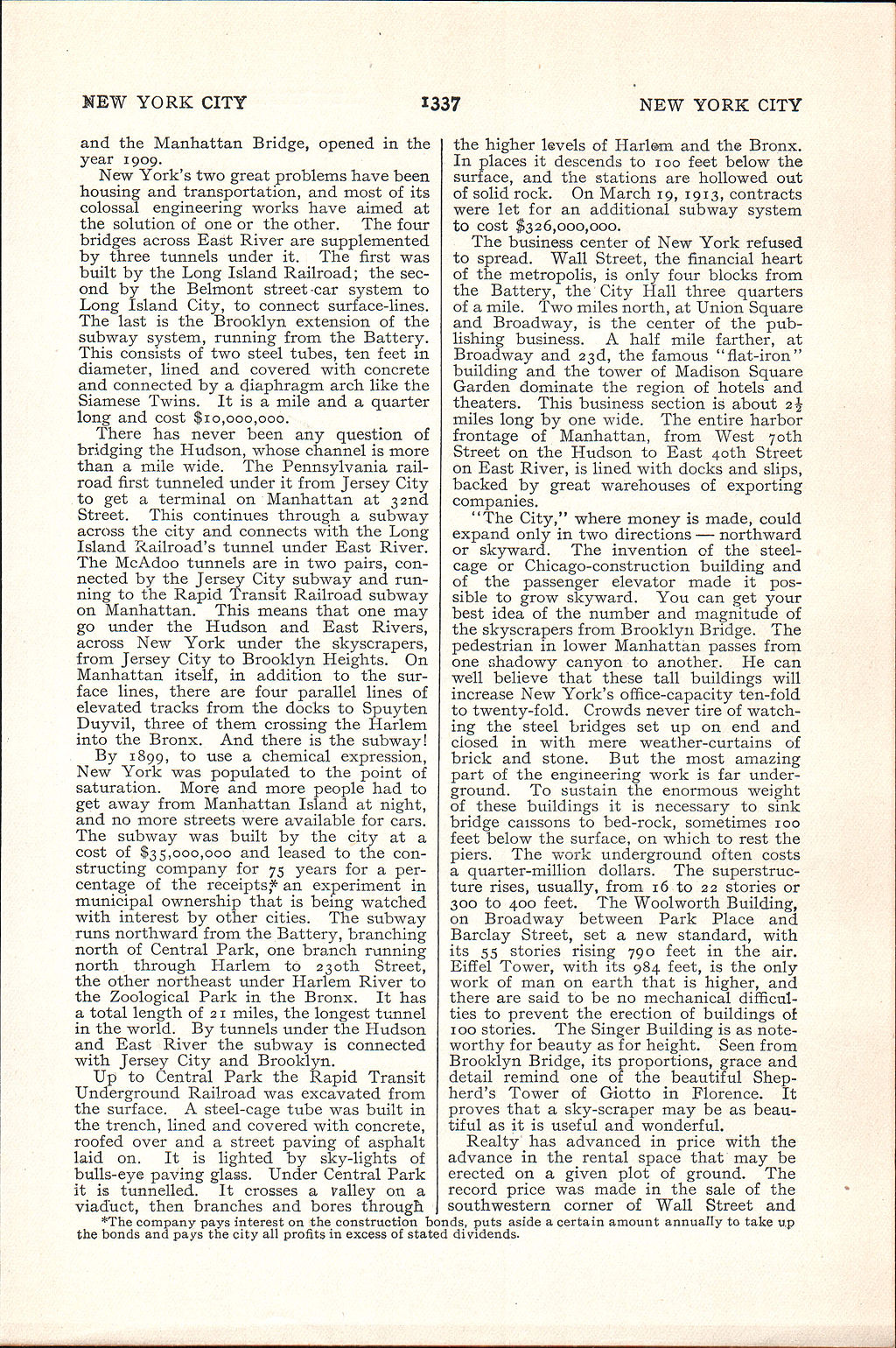and the Manhattan Bridge, opened in the year 1909.
New York's two great problems have been housing and transportation, and most of its colossal engineering works have aimed at the solution of one or the other. The four bridges across East River are supplemented by three tunnels under it. The first was built by the Long Island Railroad; the second by the Belmont street-car system to Long Island City, to connect surface-lines. The last is the Brooklyn extension of the subway system, running from the Battery. This consists of two steel tubes, ten feet in diameter, lined and covered with concrete and connected by a diaphragm arch like the Siamese Twins. It is a mile and a quarter long and cost $10,000,000.
There has never been any question of bridging the Hudson, whose channel is more than a mile wide. The Pennsylvania railroad first tunneled under it from Jersey City to get a terminal on Manhattan at 32nd Street. This continues through a subway across the city and connects with the Long Island Railroad's tunnel under East River. The McAdoo tunnels are in two pairs, connected by the Jersey City subway and running to the Rapid Transit Railroad subway on Manhattan. This means that one may go under the Hudson and East Rivers, across New York under the skyscrapers, from Jersey City to Brooklyn Heights. On Manhattan itself, in addition to the surface lines, there are four parallel lines of elevated tracks from the docks to Spuyten Duyvil, three of them crossing the Harlem into the Bronx. And there is the subway!
By 1899, to use a chemical expression, New York was populated to the point of saturation. More and more people had to get away from Manhattan Island at night, and no more streets were available for cars. The subway was built by the city at a cost of $35,000,000 and leased to the constructing company for 75 years for a percentage of the receipts,[1] an experiment in municipal ownership that is being watched with interest by other cities. The subway runs northward from the Battery, branching north of Central Park, one branch running north through Harlem to 230th Street, the other northeast under Harlem River to the Zoological Park in the Bronx. It has a total length of 21 miles, the longest tunnel in the world. By tunnels under the Hudson and East River the subway is connected with Jersey City and Brooklyn.
Up to Central Park the Rapid Transit Underground Railroad was excavated from the surface. A steel-cage tube was built in the trench, lined and covered with concrete, roofed over and a street paving of asphalt laid on. It is lighted by sky-lights of bulls-eye paving glass. Under Central Park it is tunnelled. It crosses a valley on a viaduct, then branches and bores through the higher levels of Harlem and the Bronx. In places it descends to 100 feet below the surface, and the stations are hollowed out of solid rock. On March 19, 1913, contracts were let for an additional subway system to cost $326,000,000.
The business center of New York refused to spread. Wall Street, the financial heart of the metropolis, is only four blocks from the Battery, the City Hall three quarters of a mile. Two miles north, at Union Square and Broadway, is the center of the publishing business. A half mile farther, at Broadway and 23d, the famous "flat-iron" building and the tower of Madison Square Garden dominate the region of hotels and theaters. This business section is about 2½ miles long by one wide. The entire harbor frontage of Manhattan, from West 70th Street on the Hudson to East 40th Street on East River, is lined with docks and slips, backed by great warehouses of exporting companies.
“The City,” where money is made, could expand only in two directions — northward or skyward. The invention of the steel-cage or Chicago-construction building and of the passenger elevator made it possible to grow skyward. You can get your best idea of the number and magnitude of the skyscrapers from Brooklyn Bridge. The pedestrian in lower Manhattan passes from one shadowy canyon to another. He can well believe that these tall buildings will increase New York's office-capacity ten-fold to twenty-fold. Crowds never tire of watching the steel bridges set up on end and closed in with mere weather-curtains of brick and stone. But the most amazing part of the engineering work is far underground. To sustain the enormous weight of these buildings it is necessary to sink bridge caissons to bed-rock, sometimes 100 feet below the surface, on which to rest the piers. The work underground often costs a quarter-million dollars. The superstructure rises, usually, from 16 to 22 stories or 300 to 400 feet. The Woolworth Building, on Broadway between Park Place and Barclay Street, set a new standard, with its 55 stories rising 790 feet in the air. Eiffel Tower, with its 984 feet, is the only work of man on earth that is higher, and there are said to be no mechanical difficulties to prevent the erection of buildings of 100 stories. The Singer Building is as noteworthy for beauty as for height. Seen from Brooklyn Bridge, its proportions, grace and detail remind one of the beautiful Shepherd's Tower of Giotto in Florence. It proves that a sky-scraper may be as beautiful as it is useful and wonderful.
Realty has advanced in price with the advance in the rental space that may be erected on a given plot of ground. The record price was made in the sale of the southwestern corner of Wall Street and
- ↑ The company pays interest on the construction bonds, puts aside a certain amount annually to take up the bonds and pays the city all profits in excess of stated dividends.
